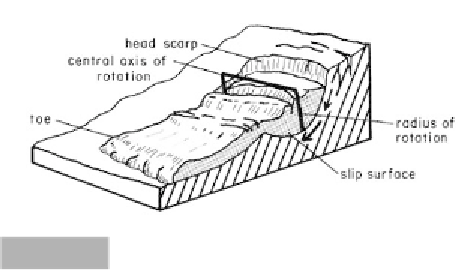Geoscience Reference
In-Depth Information
head scarp
central axis of
rotation
toe
radius of
rotation
slip surface
The process of rotational sliding (Whittow, 1980, ©
and reproduced with the permission of John Whittow,
Department of Geography, University of Reading).
Fig. 12.12
Aerial view of erosion and debris flow deposition during
the Caracas, Venezuela, urban flood of December 1999.
The deposit is up to 6 m in thickness and contains
1.9 million m
3
of sediment. Gaps denote areas where
buildings were removed by the floods (photo by
Lawson Smith, United States Geological Survey,
<http://pubs.usgs.gov/of/2001/ofr-01-0144/
Venezuela/tnhires/pages/image030.htm>).
Fig. 12.11
cracks across the body of the slipped mass and ten-
sional cracks above the head scarp. These tensional
cracks can be lines of failure for future slides. The toe
of the slide controls the terminal point of the failure.
Interference with the toe of the slide can also initiate
further failure.
Causes
Land
slides and slumps
(Sharpe, 1968; Finlayson & Statham, 1980; Crozier, 1986)
Mechanics
With landslides and slumps, not only is the stress
applied to the area of potential failure important but
the behavior of the toe also becomes crucial to the
timing of the slide. One of the major causes of land-
slides is undercutting of the basal toe in some manner.
The causes of landslides in any form are thus multi-
tudinous. Geological or topographical factors condition
the location of a potential slide. If weathered or
unweathered bedrock contains inherent lithological or
structural weakness, then these areas will favor slide
failure. Lithologically favorable material includes
leached, hydrated, decomposed, chloritic, or micaceous
rocks, shales, poorly cemented sediments, or uncon-
solidated material. Additionally, if this material is
well-rounded or contains clay, then it will flow more
freely under pressure. Stratigraphically favorable
conditions for landslides include massive beds overlying
weaker ones, alternating permeable and impermeable
beds, or clay layers. Structurally favorable conditions
include steeply or moderately dipping foliations,
cleavage, joint, fault, or bedding planes. Rock that
is strongly fractured, jointed, or contains parallel
alignment of grains because of crushing, folding,
faulting, earthquake shock, columnar cooling or desic-
cation is also likely to fail. Internal deformation
structures resulting from tectonic movement, solution
(Leopold et al., 1964; Chowdhury, 1978; Whittow, 1980)
Slope failure causing landslides can be modelled using
the Mohr-Coulomb equation. Because many slides
occur along a distinct shear plane, this equation can be
modified to include the effects of shear planes within
an unconsolidated deposit, bedding planes and joints
in weathered or unweathered bedrock, and the
presence of a watertable. Landslides, therefore, tend
to happen in two different types of material, consisting
of either bedrock or unconsolidated sediment, usually
clay. In the simplest case, where the Mohr-Coulomb
equation is easily applied, landslides move downslope
parallel to the line of failure. However, landslides can
undergo rotation as well. In this case, the failure
develops slowly as a
slump
. Figure 12.12 illustrates this
process of rotational sliding or slumping. While the
mechanics of rotation are the same as a simple planar
slide, the movement of the material is determined by
the arc of rotation centered at a point outside the slip
material. Rotational slides can be discussed in terms of
a head scarp, where the material has separated from
the main slope; a slip surface, upon which the material
rotates; and a toe, which consists of the debris from the
failure. Rotational slides may also generate transverse




















